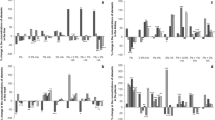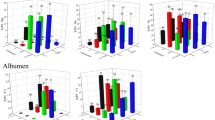Abstract
A series of experiments was conducted to study the effects of dietary and injected lead (as Pb acetate-3H2O) and of dietary Cd, Hg, and Se on fatty acid composition of serum lipids of chicks as measured by gas-liquid chromatography. The effect of dietary Pb on fatty acid composition of erythrocyte membranes was measured also. Dietary Pb (1000 ppm) increased the serum concentration of arachidonic acid (20:4, first no. = no. of carbon atoms:second no. = no. of double bonds) and decreased the concentration of linoleic acid (18:2) and the ratio 18:2/20:4. Intraperitoneal injection of Pb (52 mg/100 g body weight) did not alter serum fatty acid composition by 4 h post-injection. The separate effects of 2000 ppm Pb, 60 ppm Cd, 500 ppm Hg, and 10 ppm Se added to the diet on serum fatty acids were measured in a single experiment. In comparison to controls, Pb and Cd lowered serum concentration of 18:2. Only Pb raised serum 20:4. Pb lowered the ratio 18:2/20:4, whereas Cd and Hg raised the ratio and Se was without effect. Dietary Pb (2000 ppm) raised the concentration of 20:4 and lowered the ratio 18:2/20:4 in erythrocyte membranes. The different effects of injected and dietary Pb on the serum 18:2/20:4 ratio suggest that Pb alters 20:4 synthesis from 18:2 rather than mobilization of 20:4 from tissues. The Pb-induced increase of lipid peroxida-tion in erythrocytes observed by other workers may be a reflection of increased 20:4 level in erythrocyte membranes.
Similar content being viewed by others
References
W. E. Donaldson and T. K. Leeming,Toxicol. Appl. Pharmacol. 73 119 (1984).
N. L. Murty, M. C. Williams, and R. Reiser,J. Nutr. 72, 451 (1960).
R. T. Holman and H. Mohrhauer,Acta Chem. Scand. 17,Suppl 1, 884 (1963).
E. K. O’Hea and G. A. Leveille,Comp. Biochem. Physiol. 30, 149 (1969).
O. A. Levander, V. C. Morris, and R. J. Ferretti,J. Nutr. 107, 363 (1977).
J. J. Cunningham and J. H. Soares,Nutr. Kept. Int. 23, 205 (1981).
Statistical Analysis Systems (1979) SAS User’s Guide. Cary, NC 27511.
G. Hevesy and J. Ottensen,Nature 156, 534 (1945).
G. P. Rodnan, F. G. Ebaugh, Jr., and M. R. S. Fox,J. Hematol. 12, 355 (1957).
World Health Organization,Environmental Health Criteria 3: Lead, Geneva, 1977.
M. Sifriand W. G. Hoekstra,Fed. Proc. 37, 757 (1978).
E. R. Ramstoeck, W. G. Hoekstra, and H. E. Ganther,Toxicol. Appl. Pharmacol 54, 251 (1980).
Author information
Authors and Affiliations
Rights and permissions
About this article
Cite this article
Donaldson, W.E. Effects of dietary lead, cadmium, mercury, and selenium on fatty acid composition of blood serum and erythrocyte membranes from chicks. Biol Trace Elem Res 7, 255–262 (1985). https://doi.org/10.1007/BF02989250
Received:
Accepted:
Issue Date:
DOI: https://doi.org/10.1007/BF02989250
Index Entries
- Lead, and blood fatty acids
- cadmium, and blood fatty acids
- mercury, and blood fatty acids
- selenium, and blood fatty acids
- erythrocyte membranes, and Pb, Cd, Hg, and Se
- fatty acid composition, and Pb, Cd, Hg, and Se
- blood serum, and Pb, Cd, Hg, and Se
- serum, and Pb, Cd, Hg, and Se
- membranes, Pb, Cd, Hg, and Se effects on erythrocyte




